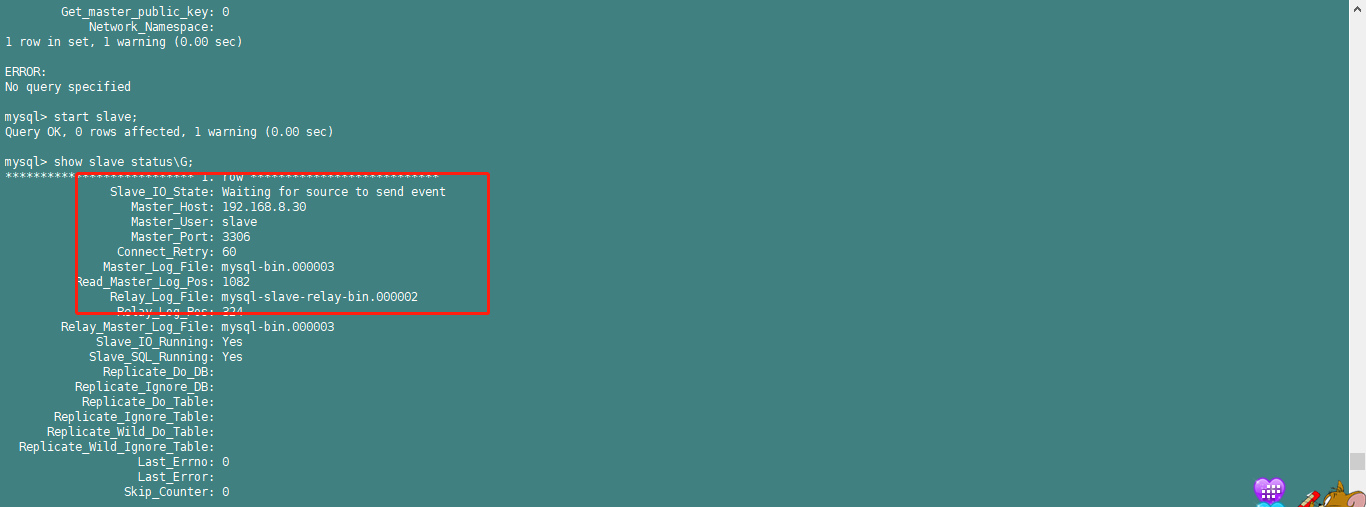Principle of master-slave replication
- The Master records the data changes in the binary log, that is, the file specified in the configuration file log bin,
These records are called binary log events - Slave reads binary log events in the Master through I/O threads and writes them to its relay log
- Slave redoes the events in the relay log and executes the event information in the relay log one by one locally
The data is stored locally, so as to reflect the changes to its own data (data replay)
matters needing attention
- The operating system version and number of bits of the master-slave server are consistent
- The versions of Master and Slave databases should be consistent
- The data in the Master and Slave databases should be consistent
- The Master starts the binary log, and the Master and Slave servers_ ID must be unique in LAN
Master slave replication configuration steps
Configuration on Master
- mount this database
- Modify the database configuration file to indicate the server_id, enable binary log (log bin)
- Start the database and check the current log and position number
- Log in to the database and authorize the data replication user (the IP address is the slave IP address. If it is a two-way master-slave, here you also need to authorize the local IP address. At this time, your own IP address is the slave IP address)
- Back up the database (remember to lock and unlock)
- Transfer backup data to Slave
- Start database
Configuration on Slave
- Install database;
- Modify the database configuration file to indicate the server_id (if you are building a two-way master-slave, you should also turn on binary
Log bin); - Start the database and restore the backup;
- Check the current log and position number (one-way master-slave is not required, two-way master-slave is required);
- Specify the address, user, password and other information of the Master;
- Turn on synchronization to view the status
Install MySQL 8
Download address:
http://mirrors.ustc.edu.cn/mysql-ftp/Downloads/mysql-8.0.27-1.el7.x86_64.rpm-bundle.tar
Decompression:
tar -xf mysql-8.0.27-1.el7.x86_64.rpm-bundle.tar
Uninstall the system's own Mariadb:
rpm -qa | grep mariadb
RPM - E -- Mariadb found by nodeps
Uninstall MySql from the system:
rpm -qa | grep mysql
RPM - E -- mysql found by nodeps
Installation:
rpm -Uvh *.rpm --nodeps --force
MySQL 8 common configurations:
[client] default-character-set=utf8 socket=/home/mysql/data/mysql.sock [mysqld] character-set-server=utf8 collation-server=utf8_general_ci max_connections=5000 expire_logs_days=7 lower_case_table_names=1 datadir=/home/mysql/data socket=/home/mysql/data/mysql.sock log-error=/var/log/mysqld.log pid-file=/var/run/mysqld/mysqld.pid sql_mode=STRICT_TRANS_TABLES,NO_ENGINE_SUBSTITUTION [mysql] default-character-set=utf8
Master slave replication configuration
Enable binlog on the master node
vi /etc/my.cnf
[mysqld] log-bin=mysql-bin server-id=1
Specifies that the slave node is globally unique
vi /etc/my.cnf
[mysqld] server-id=2
Start MySql
systemctl start mysqld systemctl status mysqld
Turn on remote login
View initial password:
grep 'temporary password' /var/log/mysqld.log
Reset password:
Modify the password to match the rules first:
ALTER USER 'root'@'localhost' IDENTIFIED WITH MYSQL_NATIVE_PASSWORD BY 'Konglcwqy123@';
Modify password policy again:
set global validate_password.policy=LOW; set global validate_password.policy=0; set global validate_password.length=4; ALTER USER 'user name'@'localhost' IDENTIFIED WITH MYSQL_NATIVE_PASSWORD BY 'New password';
Turn on remote login:
create user 'user name'@'%' identified by 'password'; grant all on *.* to 'user name'@'%';
Sign in:
mysql -uroot -p
Set up remote login
The master node creates users for master-slave replication
mysql> CREATE USER 'user name'@'Slave node address' IDENTIFIED WITH mysql_native_password BY 'password'; mysql> GRANT REPLICATION SLAVE ON *.* TO 'user name'@'Slave node address'; mysql> flush privileges;
Gets the location of the primary node binlog
mysql> SHOW MASTER STATUS;
Set the information of the master node at the slave node
mysql> CHANGE MASTER TO MASTER_HOST='Master node address', MASTER_USER='Master slave copy user name', MASTER_PASSWORD='Master slave copy password', MASTER_LOG_FILE='Query above File', MASTER_LOG_POS=Query above Position;
View master-slave synchronization status
mysql> show slave status\G;
Turn on master-slave synchronization
mysql>start slave;
View status again
mysql> show slave status\G;
